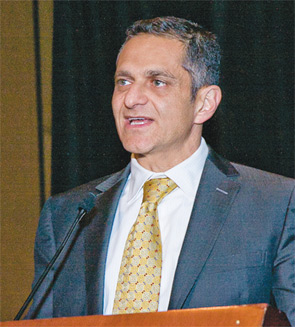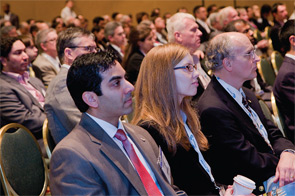
Explore This Issue
May 2012—Mark Courey, MD
SAN DIEGO — Lasers may have first been introduced into medicine 60 years ago, but removing disease while keeping healthy tissue intact can still be a complicated proposition, said Mark Courey, MD, director of the University of California San Francisco Voice Center, who gave a State of the Art Lecture here on April 20 at the 115th Annual Meeting of the Triological Society. The meeting was held as part of the Combined Otolaryngology Spring Meetings.
Understanding the mechanics behind lasers and the biological mechanics at work when the laser meets the tissue is crucial in getting the best patient results, he said.
Techniques
Dr. Courey emphasized the importance of appreciation of the thermal diffusion coefficient, the time it takes for the heat energy to dissipate into the surrounding tissue. The longer the surrounding tissues are exposed to the heat created by the laser, the more likely it will become injured or die, he said.
Time is the key; It’s not the exposure to the heat, but how long the exposure lasts, Dr. Courey said.
“If you move your hand through a candle flame quickly enough, you won’t feel the heat, but if you park it in the candle flame you’ll begin to feel the heat,” he said. “In a similar manner, if you turn the laser off and turn it on rapidly and then turn it right off, the energy generated will be absorbed as heat by the target chromophore and then the rest of the tissue won’t feel the heat.” A chromophore, he reminded the audience, is an atom or molecule that gives the skin its color and can absorb light at a certain wavelength.
“[By] turning the laser on and off for very brief periods, nanoseconds to milliseconds, the laser energy can be deposited into the target tissue at relatively high levels,” Dr. Courey said. “And it results in destruction of the target tissue before excess heating occurs in the surrounding tissue.”
For CO2 lasers, creating an immediate effect that’s seen as a tissue loss, a continuous wave for a tenth of a second will create a pattern of ablation that will make a zone of surrounding heat damage.
Pulsing it, though, can help avoid that. “Nowadays, we pulse the CO2 laser and by pulsing lengths in the range of microseconds, that allows the CO2 laser energy to be absorbed by the water molecules and diffuse minimally into the surrounding tissue,” Dr. Courey said. He cautioned that repeating the pulses too quickly can still allow “sub-ablative” heat energy to build up, which can lead to heat damage.
Dr. Courey noted the difference between application of a laser for a tenth of a second and pulsing them.
A wavelength for a tenth of a second with a CO2 laser results in thermal injury that’s 200 microns deep; for the KTP laser, it’s 700 microns. Pulsed, however, the thermal injury is reduced to 25 microns for CO2 and 200 microns for the KTP.
Movement of the laser is also critical in carefully controlling the amount of time the laser comes into contact with its target tissue.

Ideal Durations
Dr. Courey showed theoretical parameters for tissue interaction with a CO2 laser using a micromanipulator and a computer to apply the laser. The result was “relatively minimal heat dispersion in the rest of the tissue.” The disadvantages are that general anesthesia is required and that skill is needed to get a line of sight with the instrumentation.
For the pulsed-dye laser, 450 microseconds was the chosen pulse duration, but that can potentially rupture vessel walls due to inadvertent heat transfer to the vessel wall cells, which do not contain the chromophore targeted by the PDL. Vessel wall rupture allows blood products to leak into the tissue outside the vessel.
Because of difficulty with vessel wall rupture, surgeons are starting to use the KTP laser, which is an Nd:Yag laser with double the frequency and with pulse durations between 1 to 100 milliseconds. This helps to reduce the vessel wall rupture seen with the PDL. “We need, as surgeons, to be aware of the actual depth of the non-specific heat diffusion that occurs in all forms of laser injury,” Dr. Courey said.
Continuing Education
Session moderator Albert Merati, MD, chief of laryngology Service in the department of otolaryngology-head and neck surgery at the University of Washington Medical Center, said surgeons need to stay up on the details of the technology.
“There’s no substitute for staying up to date on the basic principles of laser tissue interaction,” he said. “It’s okay to know how it worked for you every day for the last two years, but we are all better off knowing what the fundamentals are.”
Technology always comes with some drawbacks, he said. “Any surgeons using any tool carelessly or in an uninformed manner probably cause more damage than they should,” he added. “I would say none of that’s unique to the laser.”
Leave a Reply